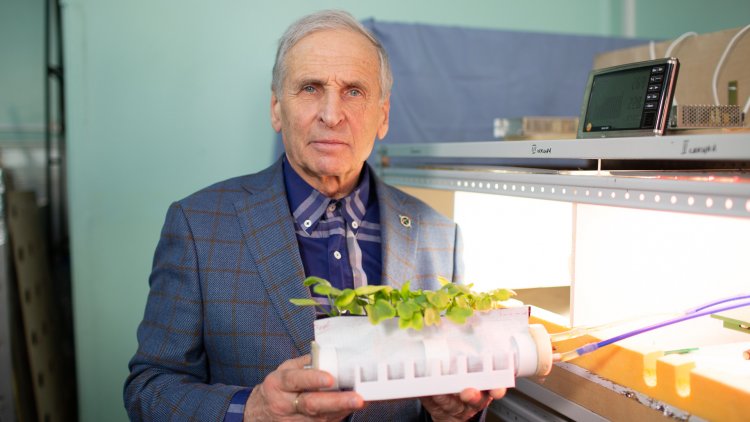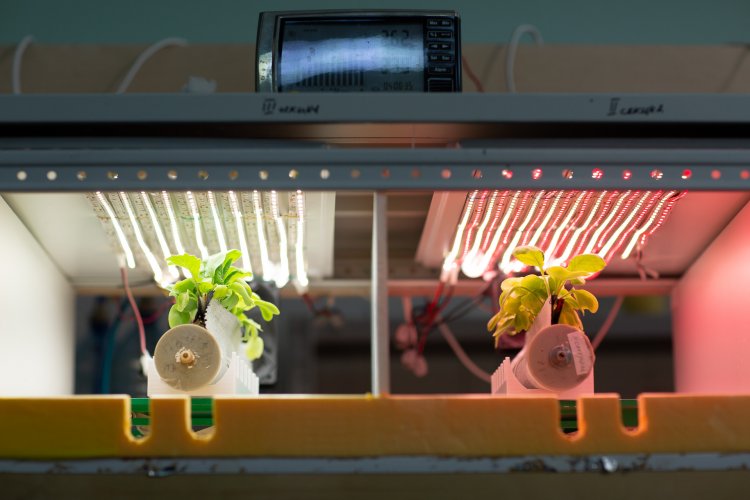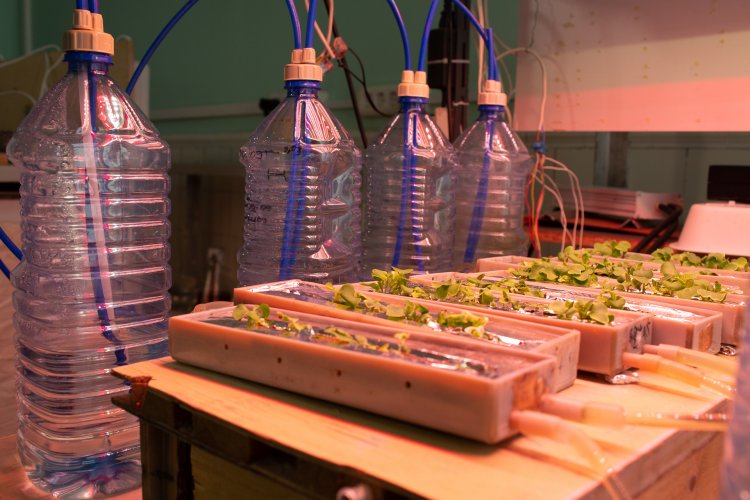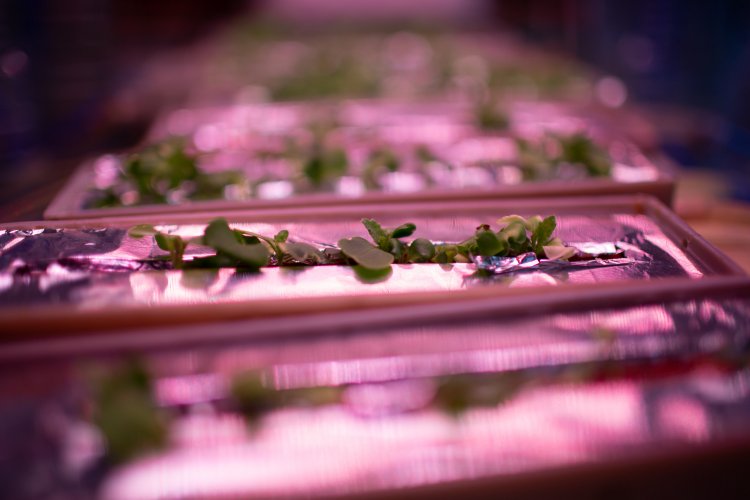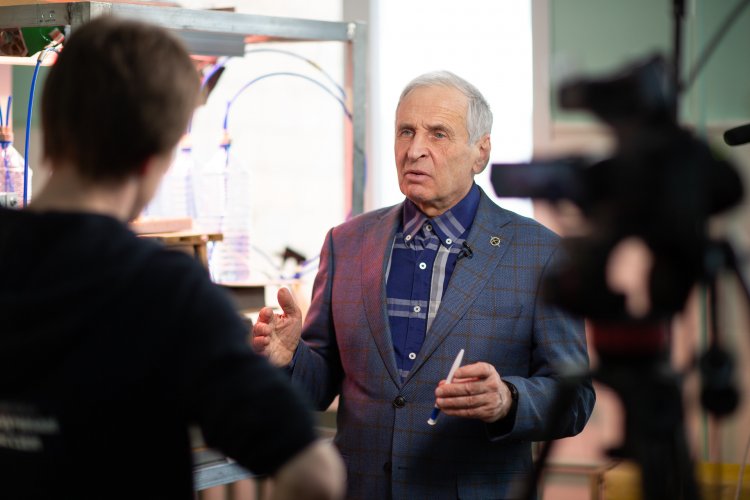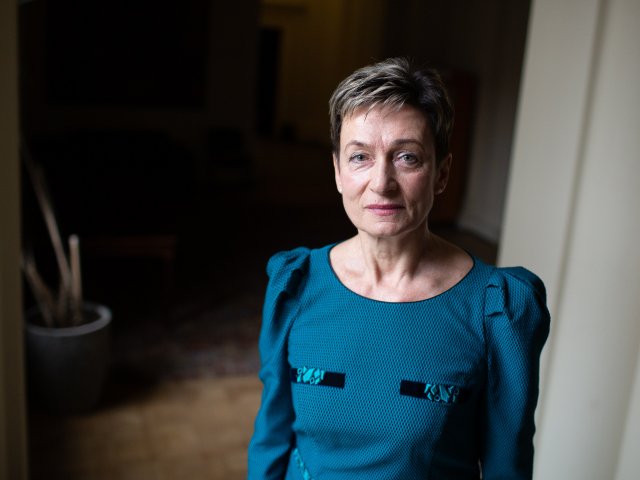It is important to ensure there is a source of vitamins for cosmonauts during long-term autonomous space missions to the Moon or Mars. Deep-frozen or canned vegetables, fruit, and greens cannot retain necessary nutrients for two-three years, which is about the amount of time a long space mission normally lasts. The shelf life of synthetic vitamin complexes is also no more than a year. Space nutrition experts point out the need to grow vitamin-rich greens and vegetables right on board a spacecraft.
What crops are most suitable for growing in zero gravity? What difficulties did scientists face when trying to grow vegetables and greens in space? What does the innovative Russian space greenhouse look like? Yuly Aleksandrovich Berkovich, Doctor of Technical Sciences, Professor, Head of Laboratory at the Institute of Biomedical Problems (IMBP) of the Russian Academy of Sciences (RAS), answers these questions.
Yuly Aleksandrovich Berkovich, Doctor of Technical Sciences, Professor, Head of Laboratory at the Institute of Biomedical Problems
Photo: Andrey Luft, Scientific Russia
— The idea of growing plants in space to feed cosmonauts and restore the gaseous spacecraft environment was originally advanced by Konstantin Tsiolkovsky well ahead of the first manned flights. How was the development of space greenhouses started?
— Indeed, it was as far back as the end of the 19th century, when Konstantin Tsiolkovsky proposed to use plants in long-term space missions to create the cycle of matter in a confined space.
Almost all organisms on Earth can be divided into two large groups: autotrophs and heterotrophs. Autotrophs use light energy to produce biomass from water and carbon dioxide, while heterotrophs consume biomass produced by autotrophs.
Konstantin Tsiolkovsky noticed that autotrophic and heterotrophic organisms, that is, plants, and all other creatures on Earth, were in symbiosis. Plants use sunlight to produce biomass and oxygen, whereas humans consume this biomass as they inhale oxygen and exhale carbon dioxide. Konstantin Tsiolkovsky proposed to use the knowledge about this well-understood relationship in space flights.
When Yuri Gagarin’s flight started the era of manned space exploration, Soviet and foreign scientists turned to Tsiolkovsky’s idea. They started evaluating the possibility of designing a system that would allow obtaining food by growing it directly on board a spacecraft.
A lot of research studies were carried out then. It turned out that it was quite expensive to grow plants in space. First of all, in addition to carbon dioxide and water, plants need a significant number of other elements to produce biomass. Secondly, it is necessary to use special equipment to grow plants in zero gravity or under conditions other than earth gravity conditions.
Photo: Andrey Luft, Scientific Russia
— What plant was first grown in space and when? What accompanying studies were carried out?
— Tulips were some of the first plants grown in space. In 1971, the cosmonauts of the Salyut and Soyuz stations carried out the first experiments using Vazon. The equipment was quite simple: a small cartridge with water and growth medium, that is, a capillary belt, was placed under a tulip bulb, and the cosmonauts would manually supply liquid through a connection pipe.
However, plants were grown from a bulb in this experiment, which was significantly easier than growing plants from seeds. The point is that bulbs store elements that facilitate growth at its early stages. They contain elements that provide a plant with everything it needs, including resistance to adverse factors.
At that moment, scientists were largely preoccupied with the question of how plant growth and development would flow without Earth’s unidirectional gravity. Many scientists doubted that these processes would occur at all: some theories implied that cell growth, tissue elongation, and direction of growth would be absolutely disoriented without gravity. These assumptions were supported by experiments carried out on Earth: they demonstrated that plants planted upside down started bending the shoots against the direction of gravitational acceleration, against gravitational force. They tend to rise upwards even in the dark, not to mention the situation where the source of light is above the plant.
These studies were initially carried out using Vazon for bulbous plants and Oazis 1 for growing plants from seeds. The goal of the studies was to determine the parameters of the gravitational sensitivity of plants and the possibility of their reorientation, including on Earth, in a situation where they constantly rotate and change their position. Subsequently, Soviet scientists developed several small space greenhouses, namely, Fiton, Oazis 1m, Lyutik, Svetoblok, and others. These space greenhouses were sent to in-orbit artificial satellites. In the 1980s, the feasibility of a full life cycle (from seed to seed) of the small Arabidopsis plant in zero gravity was proved for the first time using Fiton 2.
The most difficult task was to provide plants with root nutrition. When we grow something on Earth, even using the hydroponics method, that is, we grow it without soil, the gravity of Earth helps us. It sets the direction of root growth, while gravitational flow provides the plants with nutrients. This flow does not exist under the conditions of orbital flights due to the absence of unidirectional gravity.
This problem was solved in different ways at first. For example, gel-like agar-based nutrient media or combinations of hydrophilic and hydrophobic threads were used to supply water saturated with nutrients to plant roots using capillary forces in capillary-porous media. Equipment units with different methods of water supply to the root system were sent into Earth's orbit with varying success for almost 20 years.
They managed to design a reliable system after scientists had closely examined the movement of liquids and gases in capillary-porous media under zero-gravity conditions.
In 1982, our institute was commissioned a task of designing a space greenhouse where it would be possible to grow a plant from a seed to a marketable product. This project was carried out under Interkosmos, an organization that united all socialist countries. In 1990, together with Bulgarian specialists, we finished the design of Svet and sent the equipment to the Mir Space Station, where they used it for ten years until the station was deorbited.
— What tasks had to be solved besides adapting the growth direction and supplying the root system with nutrients?
— To grow plants in space, you need to create a life support system for them, just like we provide cosmonauts with everything they need. Plants require mineral nutrition, water, light, and certain environmental characteristics: temperature, humidity, and air composition.
One of the problems was the gas composition at orbital stations. Three equipment units would simultaneously grow various crops in one spacecraft. They used different methods of water and nutrient supply as well as different temperature and light parameters. One day, all plants in all three units died. Gaseous pollutants in the cockpit were thought to be the reason.
New research studies were initiated. Additional experiments, including those carried out on Earth, demonstrated that plants were significantly more sensitive to the toxic effects of gaseous pollutants than humans. The concentration of certain pollutants can fluctuate in the small interior volume of orbital stations. Up to a hundred substances can be found in the atmosphere of a spacecraft. The levels of pollutant accumulation acceptable to humans can be lethal to plants, or they can lead to serious deviations in their development.
— How was the problem of pollution in the atmosphere of space stations tackled? Did they design closed-loop plant growth systems?
— Closed plant growth chambers are mainly used by Americans. By now, they have already tested dozens of such equipment units in orbit. It should be realized that the life support system of these greenhouses is very complicated, although they make it possible to create a more controlled environment for plants. However, plants themselves release a quite large amount of pollutants. Moreover, they cannot exist without transpiration, that is, the evaporation of water from the surface of the leaves. This mechanism helps to keep the leaves at a constant temperature if the ambient temperature changes. This largely transforms the atmosphere in a confined space. The problem is that plants need carbon dioxide for photosynthesis. If we use open plant systems, plants get it from humans, but isolated plant systems require an additional source of CO2. It is necessary to control the balance of carbon dioxide and oxygen, as high oxygen concentrations are poisonous to plants. With every one percent increase in the percentage of oxygen in the air, there is a dramatic decrease in the intensity of photosynthesis and biosynthesis.
Developing complex closed plant growth systems is one of the options. Other scientists strived for realizing Konstantin Tsiolkovsky’s idea and creating a biological life support system with a shared cycle of matter within the entire spacecraft. There is no sense in isolating plants from humans if we plan to send them together on a long-duration space mission. For some time, scientists that specialize in space plant breeding tried to create these life support systems and equipment that could ensure a stable supply of organic products under zero-gravity conditions, but they gave it up relatively soon due to a number of problems.
Scientists from different countries compared the efficiency of different systems of food supply, air filtration, and water purification. One type of system was based on reserves and physicochemical regeneration processes only and the other type included biological elements, too. It turned out that the former systems are significantly more efficient in terms of size and energy usage.
The weight of all equipment units was evaluated, including spare parts, consumables, and necessary substances. The space necessary to install each type of equipment on board was compared, as every cubic inch cost a lot of money. Energy costs required for the work of the entire system were compared as well. For example, biological life support systems require additional energy resources for cooling and lighting. Crew’s labor costs associated with equipment maintenance were evaluated.
Calculations demonstrated that life support systems with biological processes were significantly inferior to physicochemical systems when it comes to missions that last several years. As to greenhouses able to produce significant amounts of organic products, they would become profitable no earlier than there are missions to Mars and other planets as well as the construction of space stations where cosmonauts would live on a rotating basis. It turned out that it would be more profitable to deliver food even to the Moon than to grow it on site. However, all these estimates did not take into account a small yet significant detail: plants significantly improve the environment.
— How do plants influence the atmosphere inside a spacecraft?
— First of all, plants enrich the environment with oxygen. Of course, high oxygen concentrations are not very useful for plant shoots, but they have a positive effect on the atmosphere inside a spacecraft and cosmonauts’ condition.
In addition, research studies demonstrated that, when plants release water vapor and oxygen, the number of negative air ions increases in the surrounding gaseous environment. Their positive influence on human health was described by a renowned Soviet scientist Alexander Chizhevsky, a friend of Konstantin Tsiolkovsky. He is also known for his monograph The Earth's Echo of Solar Storms, where he advanced a theory that changes in solar activity influenced not only the human body but also social processes. Therefore, both these scientists shared the opinion that the terrestrial biosphere and near-Earth outer space were fundamentally connected.
Plants reduce the level of stress in cosmonauts. Ground experiments with long-term isolation of the crew in a confined space showed that the presence of plants improved participants’ mental and physical condition.
— What are the criteria for choosing the most suitable plants for growing in space? What plant species are best adapted?
— Scientists have concluded that while certain plant species are required in long-duration missions, others are better suited for short-term ones. Today a ranking of various agricultural plants suitable for growing in space is available.
Leafy vegetables are the first in this ranking: they are small but vitamin-rich in biomass per unit. In addition, these vegetables have a relatively short vegetation period: it takes only 24 days to plant cabbage seeds and obtain leaves of the required size.
The coefficient of economic utility is also important, that is, the edible and inedible biomass ratio. Leafy vegetables have few roots, so the edible part makes up to 90–95%. It includes lettuce crops, radish, and Japanese turnip — both tops and roots of this plant are edible. In comparison, wheat’s ratio of edible and inedible parts is about 50%. Besides, you need to somehow dispose of the remaining wheat straw, while waste disposal in space is a huge challenge.
Plants are also chosen based on cosmonauts’ needs. If we only need carbohydrates for their diet, a specific set of plants is used. A carbohydrate-protein diet requires completely different plants. Today we have a pilot project on providing food to a six-person crew for a three-year mission to Mars and back. There are four modules for growing crops, namely, green vegetables, carrots recommended by the nutrition specialist, tomatoes, and peppers. We believe that these four types of plants will be most quickly introduced into space greenhouses.
— What is the estimated frequency, with which cosmonauts be able to eat fresh vegetables grown in space?
— To have fresh vegetables in cosmonauts’ diet on a regular basis, we used a vegetable conveyor system. We are now preparing the Vitacycle-T equipment for experiments in the Russian segment of the International Space Station (ISS). It is a new space greenhouse that is absolutely different from other systems.
Suppose it takes us 24 days to grow an edible fruit. The equipment has several modules for growing plants from seeds. These modules are filled one at a time. One root module is sown on the first day, the second module is sown in four days, the third one — in another four days, and so on. In this way, we get ripe fruits and vegetables in the first root module on the 24th day, in the second module — on the 28th day, and so on. Every four days, the equipment provides a fixed portion of lettuce.
It is the concept of a spiral cylindrical greenhouse. The spiral itself expands as plants grow in the modules to let plants receive light permanently and have room to grow. The design of the device can be changed depending on the tasks: a specifically calculated output is required to provide one person with vitamins. For two people, the equipment unit must be twice longer. To regularly get vegetables with a longer growth period, the number of modules for sowing can be increased. We grew a crop with a 40-day vegetation period — it required ten root modules, and crops were harvested every four days, with new plants sown in vacant places.
Photo: Andrey Luft, Scientific Russia
— How difficult is this equipment to use? Do cosmonauts need to be experienced in plant cultivation?
— Vitacycle-T is almost completely automated. Cosmonauts only need to insert a panel with glued seeds into a module. At the end of the process, cosmonauts take out this panel, cut off crops, and insert a new one.
Liners with soil substitutes should be replaced in these modules over time. Nothing works indefinitely, artificial substrates have a limited reserve of nutrients, and artificial soil becomes penetrated by roots after a number of vegetation cycles. It is necessary to develop a technology that would allow extending the use period of soil substitutes.
— It is unprofitable and irrational to send soil into space for vegetable growing. What replaces it in space greenhouses?
— Sending soil in space is not only unprofitable and irrational. In addition to this, soil has properties that are invisible on Earth but unpleasant on board a spacecraft. For example, soil contains a large amount of organic matter. Where there is organic matter, there is also microflora: substances are processed with the release of gases causing changes in capillary-porous properties. These characteristics change over time, and the system becomes unstable.
Moreover, soil can contain substances and microorganisms that are toxic not only to plants but also to crew members. Therefore, we need something more stable.
In the 1980s, we turned to the Institute of Physical Organic Chemistry of the Academy of Sciences of the Belorussian Soviet Socialist Republic. Academician Vladimir Soldatov worked at this institute then and still does. He was engaged in the development of ionic soils. They are synthetic zeolites that contain negatively and positively charged ions. He made small granules out of them and saturated them with mineral fertilizers using his original technology. This mixture of granules contains all necessary fertilizers. Water is supplied to a container with ion-exchange soil, and so you get a nutrient solution for plants.
Today we use soil substitutes with felt fabric instead of granular substrates. We use the following technology in collaboration with Soldatov’s protégé Vasily Matusevich: we melt ion-exchange resins, pass them through spinnerets, get fibers, saturate them with fertilizers, and make felt cloth from the fibers using weaving machines. The felt is saturated with all necessary fertilizers: anionic and cationic fibers are intertwined, and this substrate is more suitable for plants in space, as it does not decay into particles under zero-gravity conditions.
Any soil substitute runs short of nutrients with time, so we have developed a system for enriching depleted substrates with mineral salts. For this purpose, enriching cartridges are installed in the greenhouse. If necessary, irrigation water is passed through these cartridges. We constantly monitor the level of electrical conductivity in the solution. If it decreases, it is time to additionally saturate the soil substitute with nutrients.
Of course, the root systems of plants will eventually clog substrates, so they should be thrown away. However, an autonomous space mission designed for three-four years can take a supply of felt soil substitute and enriching cartridges — they are relatively small-size and low-weight.
As to decades-long missions or life in distant space stations, this should require a more profound waste recycling to obtain nutrients for fertilizers. When we grow greens, vegetables, or cereals, we consume about half of the biomass. About 50% accrue to waste and it is the recycling of this waste that can act as a source of the missing salts for fertilizers. Human waste can also be recycled more consistently: for example, recycling urine allows returning 97–98% of water now and there is a concentrated brine rich in nitrogen and salts left.
It all advances gradually: I cannot say that as we now develop a vitamin greenhouse, we disregard the rest. However, our capabilities do not allow us to cover everything. Only a small vitamin greenhouse can be sent into orbit today, as we only have about half a kilowatt of electricity for this. The current ISS power unit generates energy that is only sufficient for crew members’ essentials and routine experiments. Few resources are available for plant cultivation.
— What research studies and projects in space crop farming are prioritized today?
— Our institute is part of the Russian Academy of Sciences, so we cannot abandon fundamental science or advanced research. However, today we mainly focus on the development of plant cultivation technologies in the Vitacycle-T conveyor cylindrical vitamin space greenhouse. The design of the prototype at the Research Institute of Space Device Engineering will be completed in May.
This equipment is fully automated. Listing its features will take a long time. Most importantly, it has a cylindrical shape that allows for growing various green crops, from seeds to full-size plants, and reaping the harvest every four days. When neighboring plants grow on a cylindrical surface in space, and an LED lamp located on a larger cylindrical surface shines inwards on crops, the stems and leaves of plants strain towards the light and grow perpendicular to the planting surface, like on a cylindrical brush. As they grow, the tops of the plants move away from each other, and the upper leaves shade out the lower ones to a lesser extent. In addition, the light, in this case, is concentrated towards the center of the cylinder, which allows for more efficient illumination of lower leaves that experience light deficit under normal conditions. In this way, we considerably save both light energy and the space the equipment occupies inside the spacecraft. The size of this cylindrical greenhouse is almost twice smaller than that of a flat greenhouse with the same number of plants.
The Vitacycle-T greenhouse is very convenient to use. Both planting and harvesting are carried out through the same hatch. I even had a dream of creating a robot — in fact, we only need two automated arms to pick the ripe plant and insert a new seed bar.
Our laboratory selects crops to grow in this promising greenhouse. We have spent several years trying to work out an optimal regime for growing Russian kale. Now we want to expand the range of lettuce crops. Our plans include the cultivation of radish, Japanese turnip, and green mustard. Cosmonauts often ask for something piquant. Of course, lettuce is healthy, but cosmonauts want something spicy, so we will try to grow green mustard.
We work on different irrigation options. For example, we supply exactly as much water as plants need for transpiration. The amount of liquid depends on the light intensity, air temperature, humidity, and circulation as well as the age of crops. We learned how to manage humidity control systems in laboratory settings. We significantly reduce the water usage by adding exactly the amount of water that plants need under specific conditions.
Before sending Vitocycle-T to the ISS, we have to test it all on Earth. This equipment has many innovative features, so our laboratory has much to do.
— When is it planned to send Vitocycle-T to the ISS?
— The development of a prototype will be completed this year. Biological and technological tests and the design of two onboard samples are scheduled for the next year. In addition, it is necessary to train cosmonauts to work with this equipment. We expect to send the device to the Russian Orbital Segment of the ISS and start zero-gravity tests in about 2024. It will provide us with invaluable information, and we will be able to start developing new modules for different crops: carrots, tomatoes, and peppers.
The interview was conducted with the support of the Ministry of Science and Higher Education of the Russian Federation and the Russian Academy of Sciences.
